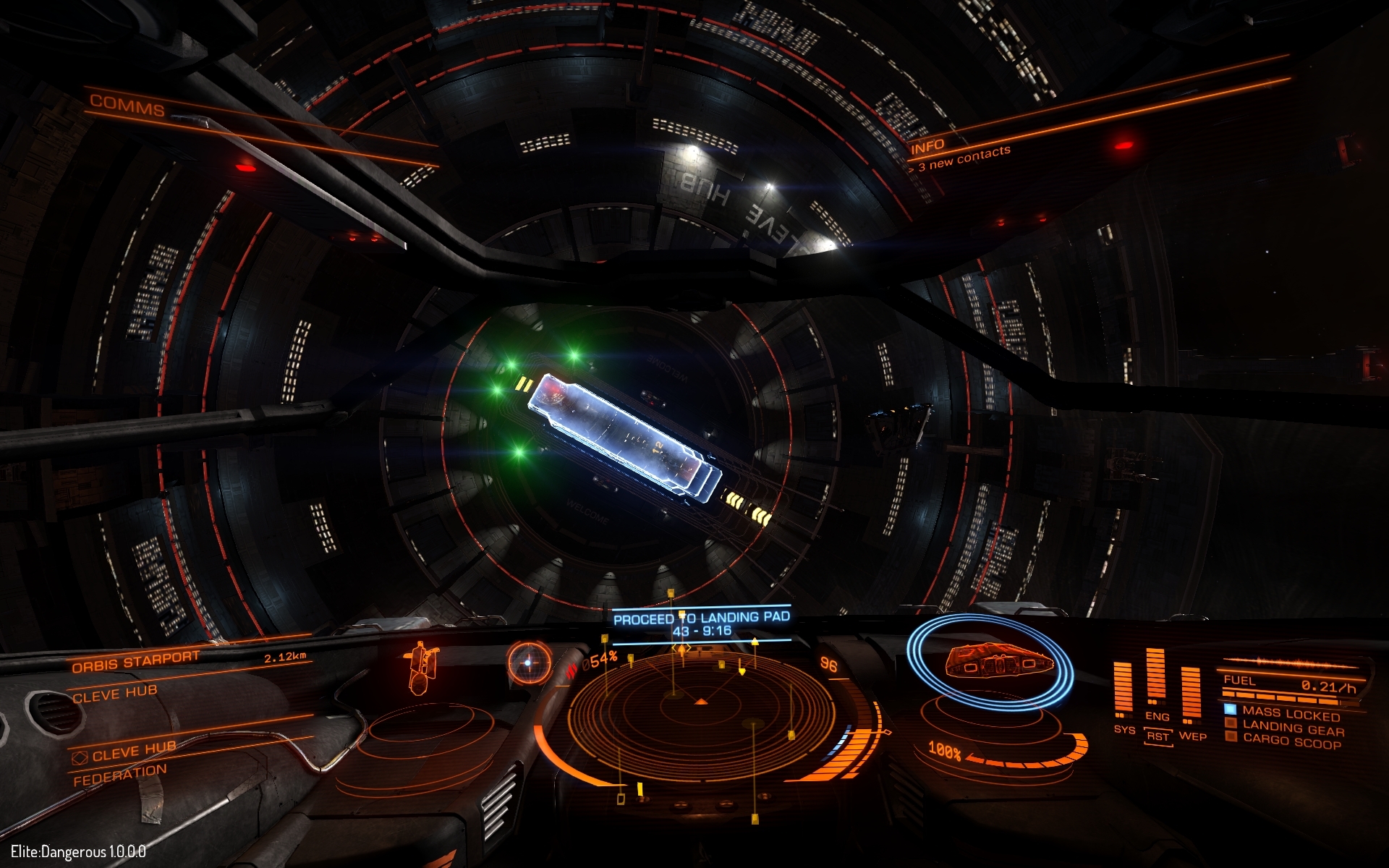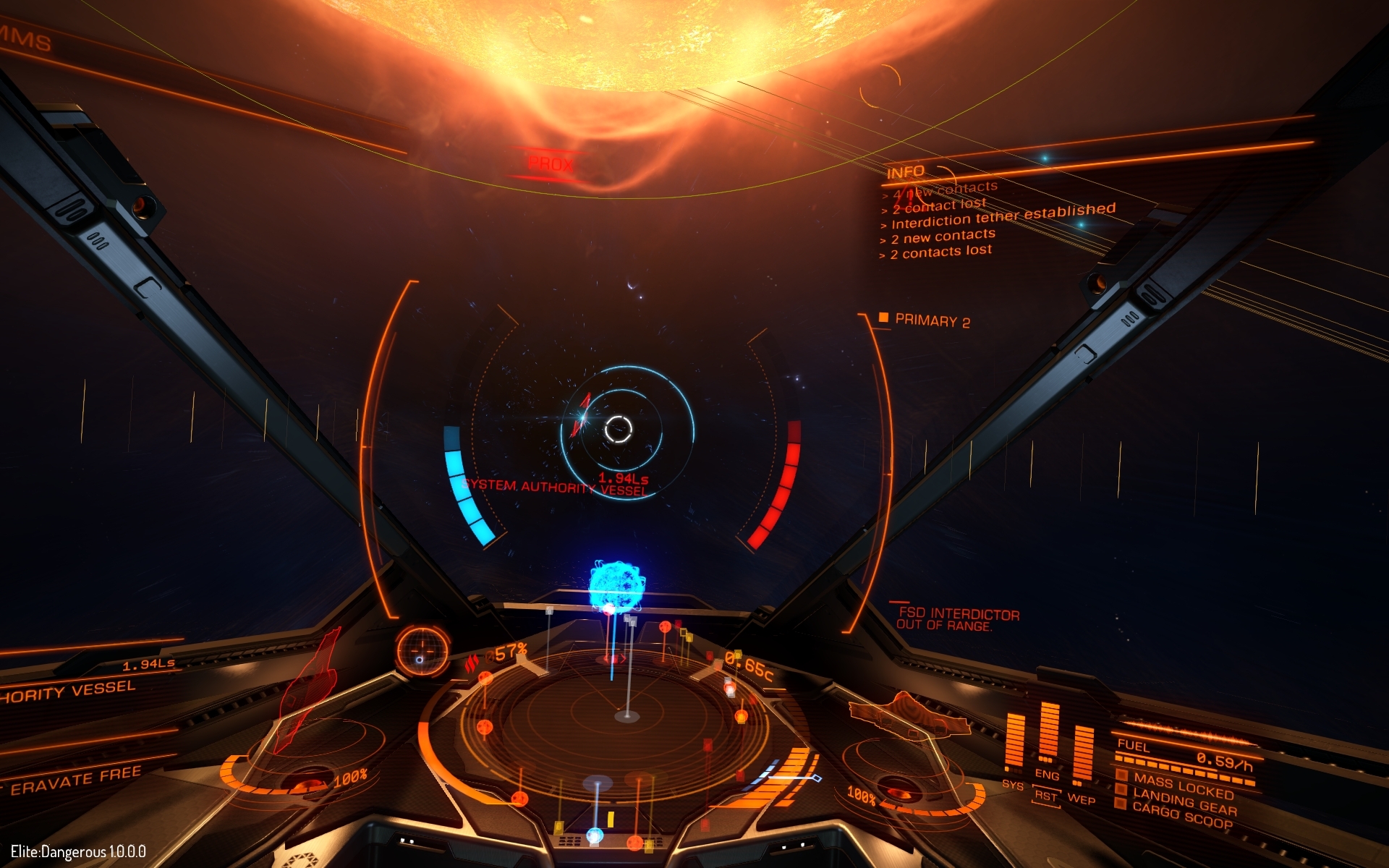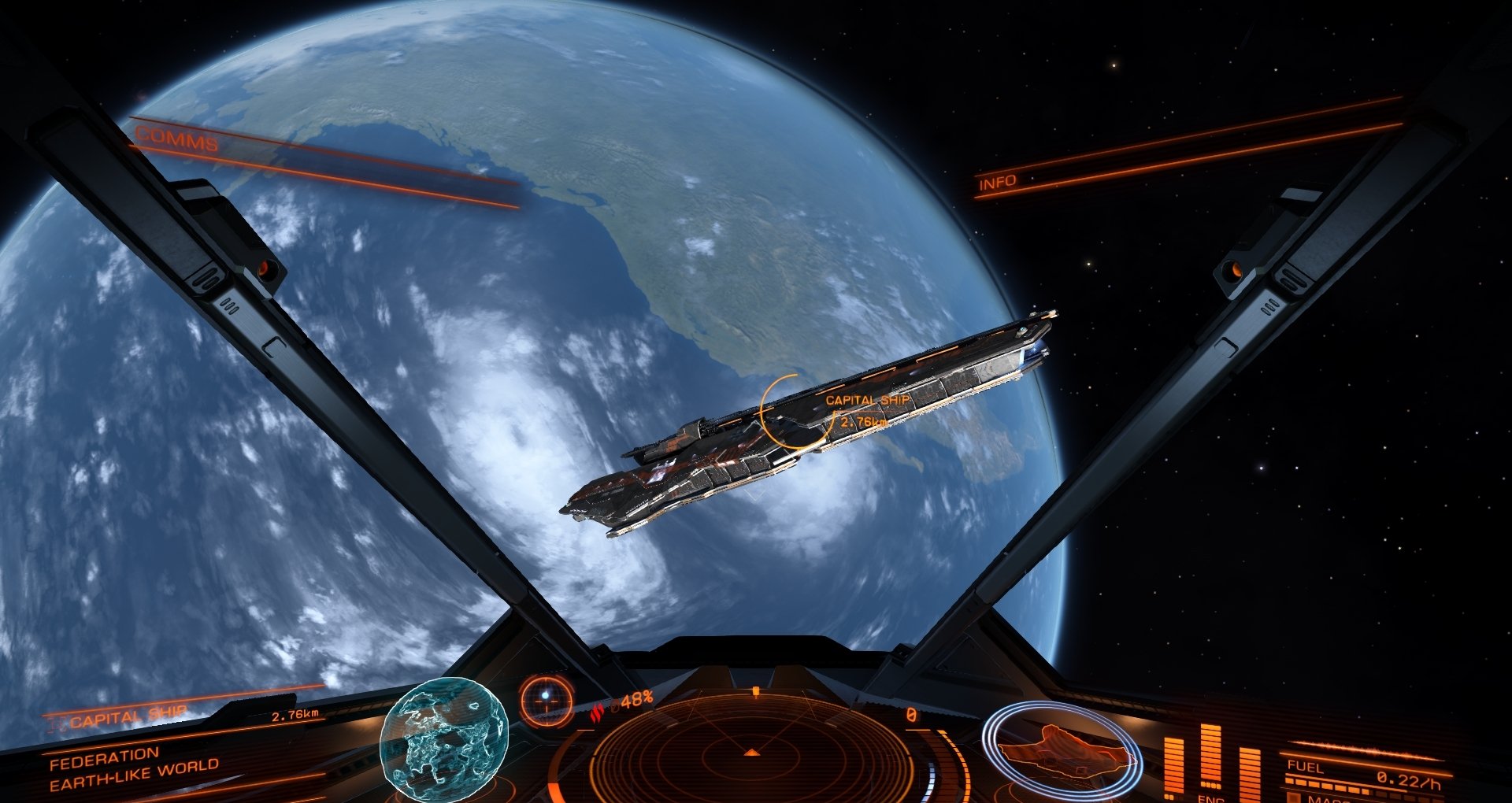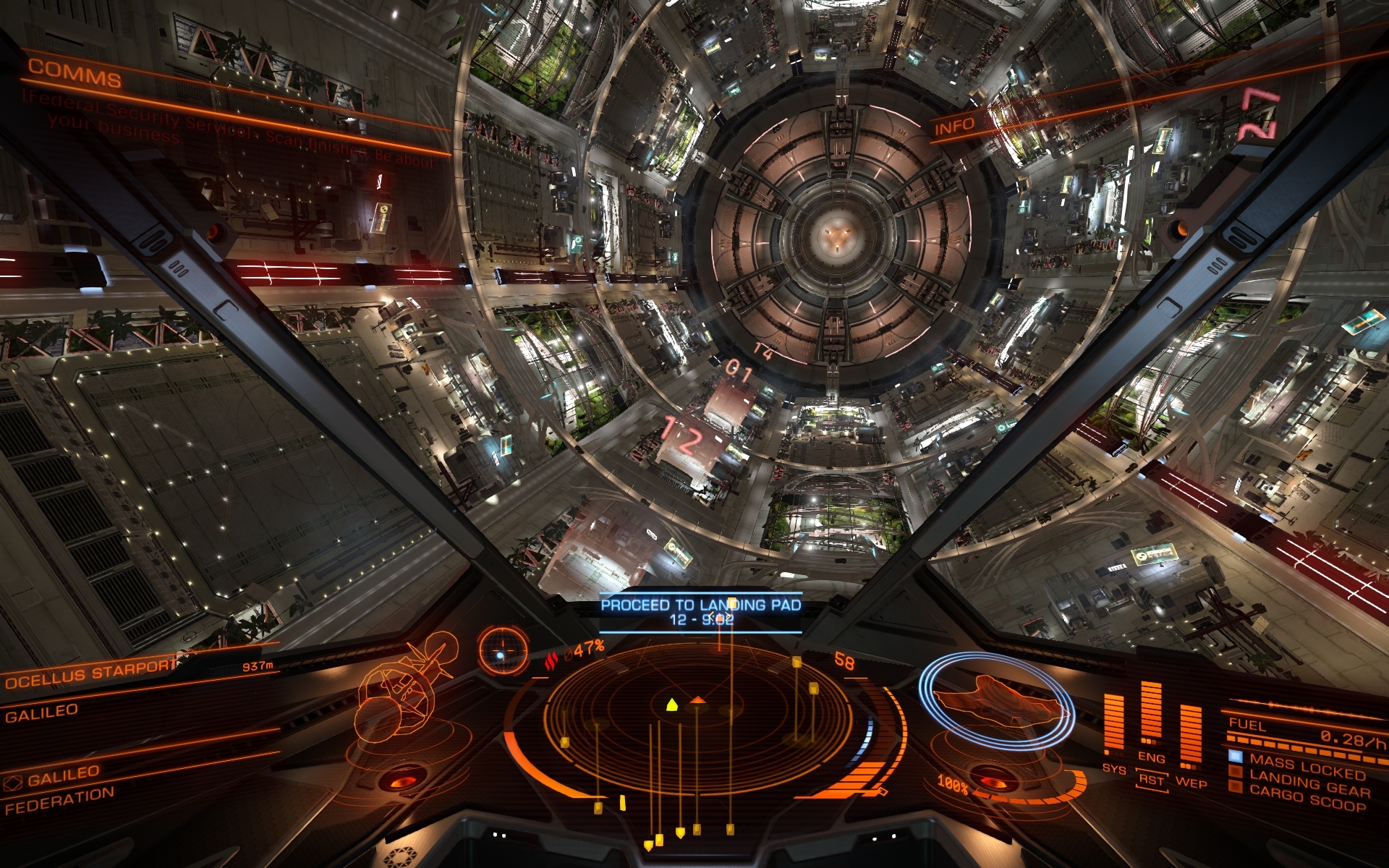Our Verdict
A great game and, with time, potentially a classic. Much rests on Frontier's ability to build on these broad but somewhat shallow foundations.
PC Gamer's got your back
What is it? Vast sequel to the original space trading and combat game.
Influenced by? Elite, Freelancer
Play it on Direct X 11, quad core CPU, 4Gb RAM, 1Gb VRAM, internet connection
Alternatively X3: Albion Prelude, 69%
DRM Online connection required
Price £40/$60
Release Out now
Developer Frontier
Publisher In-house
Multiplayer MMO (sort of)
Link Official site
Elite: Dangerous succeeds at much, but it isn't finished. I'm not sure that a game of this scale ever can be. Frontier has drawn a line under the game's lengthy beta at a point where it is, arguably, feature complete—here is a space game where you can hunt, trade, pirate, smuggle and explore across a 1:1 model of the Milky Way—but where many of those features lack the depth that might give them meaning, or the variety that might reward lasting engagement. My experience of Dangerous has been defined by moments of exhilarating excitement, matched by nothing else this year, contrasted with moments of emptiness, frustration, and boredom.
In part, Dangerous is great because it is boring. This is a sim, committed to its own part-science, part-fiction set of rules and mechanics. It's not interested in being a piece of entertainment that you pick up and consume. Elite's Milky Way is a place that you inhabit, criss-crossed by ships that behave like real machines and governed by systems of trade, law and political power that churn away according to complicated, directorless algorithms.
Other games have attempted the same, but none have approached Dangerous' degree of fidelity or visual spectacle. Every player will, at some point, tell the story of the first time they discovered a dying star or saw a capital ship materialise in the middle of a heated battle. You will, whether or not you appreciate it consciously, benefit from the extraordinary attention paid to the little things: docking animations, station detail, utterly extraordinary sound design.
It's in this regard that Frontier's work is demonstrably finished. They don't need to do a better job at representing starship user interfaces than they currently do, nor do they really need to deliver on the promise of on-foot exploration of space stations or anything along those lines. What they do need is to expand the game's capacity to generate stories about spaceships, and for those stories to have lasting meaning. I can demonstrate this, I think, by telling you a story about some spaceships.

I have found myself, somewhat arbitrarily, settling in an independent system called Psi Octantis. It's on the fringe of Imperial space, around 70 light years from our home system of Sol, and unaffected by the ongoing slave revolt in nearby Sorbago. I came here to conduct my bounty-hunting business in a simpler, quieter climate, somewhere I'd feel compelled to stay while I build my reputation and credit balance.
The choice was part practicality, part personal taste. I wanted somewhere free from any of the galaxy-spanning governments, with enough money to generate profitable contracts and at least one fully-equipped station. I found that in Psi Octantis, a system with two planets, Kanaloa and Kane, and a single station, Gernsback Settlement. Kane is a vast white gas giant, but Kanaloa is an Earth-like garden world with plenty of water. I'd quite like to go there, should Frontier ever add the ability to land on planets.
Psi Octantis is governed by a corporation and as such is free from Federation, Alliance or Imperial control. The Empire has a presence, however, in the form of a regional splinter group called the Lords of Psi Octantis. Their influence isn't high enough to shunt the sector towards Imperial dominion, but their ships are everywhere. Of the 400 billion star systems allegedly simulated, then, I chose this one: it had a pretty world, a story of fringe resistance waiting to be told, and a station named after the father of science fiction. Perfect.
Bounty hunting takes a number of forms. I could take a general contract from the bulletin board at Gernsback to kill a set number of pirates in the system. These I'd find in Unknown Signal Sources, activity nodes that spawn at random throughout space and are frequently tailored to the missions you're following—I might find a few canisters of biowaste floating in the void, or I might find a squadron of pirates to take down in pursuit of my contract. I could take a far more lucrative, far more dangerous assassination contract that would span multiple systems and signal sources. Or I could simply fly off, scan ships, and hope to come across somebody with a price on their head.

There are three 'tiers' of ship velocity. The slowest is where most of the business of the game is conducted: docking, interception and combat at speeds analogous to aircraft. Then there's supercruise, hyperaccelerated flight between points of interest in a star system. Finally, hyperdrive is used to warp between stars, your freedom limited only by the maximum range dictated by your ship's components and cargo.
It's at this second level, supercruise, that bounty hunting takes place. I head out of Gernsback, engage supercruise, and begin to glide in a smooth arc towards the centre of the system. On the way I flick through ship targets and wait for their bounty ratings to appear. A lot of 'clean'. One or two 'wanted', but for small sums—300 credits here, 1200 there. Parking violations, more or less. Then, I see her—an Imperial Clipper, belonging to the Lords of Psi Octantis, wanted for 40,000 credits. That score exceeds what I'd get for fifteen regular pirates.
I hit the throttle. The Clipper is half a system away, racing for the gas giant, Kane. If I can get close before she reaches her destination, I'll be able to establish an interdiction tether and force her out of supercruise. As I close in from behind, all the signs are good—but then my ship staggers, lurches, and the screen flashes blue and red. Interdiction. Somebody is interdicting me.

Reviewed on Intel Core i5 2500K, 16GB RAM, Nvidia GeForce GTX 970
Graphics options Field of view, V-sync, 3D, VR, ambient occlusion, UI and game brightness
Anti-aliasing FXAA, MLAAX2, MLAAX4, SMAA
Remappable controls Yes
Gamepad support Yes (including flight controllers)
Elite: Dangerous ran at a solid 60 FPS in all scenarios with everything pushed to max. Occaisional level of detail pop-in is visible when entering detailed environments, but for the most part glitches, when they occur, are due to networking issues—rubberbanding ships or slow-to-appear stations.
Evasion means chasing a careening escape vector as my opponent attempts to stay on my tail. I'm flying an Eagle, a maneuverable fighter and one of the strongest interceptors in the game, so it's unlikely that I'll be caught. But I'm wasting valuable time. When I finally shake the interdiction I hastily scan the contacts list for the Clipper. She's still there, but she's nearing Kane. Closer, closer, and then—gone. I say a bad word.
Then I decide to try something I've not attempted before. Ships exiting or entering supercruise leave behind energy signatures which can be scanned using a special device to determine their location. I don't have one, but there's a chance that if I manually disengage from supercruise at the energy signature then the Clipper will be nearby. I move in, cutting my acceleration, watching the signature approach from a few million miles away. Kane comes into view, a tiny white orb, growing. By the time I exit supercruise the gas giant occupies my entire view from one side, pearlescent, massive.
And she's still there. The Clipper's close, actually—close enough to get a decent look. These Imperial ships are white with bright blue accents, curved and delicate-seeming compared to the angular wedge-designs typical of ships elsewhere. It's also much larger than me, and I've never fought one. This raises a number of important questions: where and how numerous are its weapon hardpoints? Can it fire backwards? How durable are its shields?
40,000 credits is a lot of money at this stage in my career. It's 'learn by doing' money; the risk is worth taking. I deploy two forward-firing multicannons and a single auto-targeting burst laser and come in fast behind the Clipper. The Eagle is a cheap ship but it can out-turn any other craft in the game. My plan is to stick to her engines at knife-fight range and take no fire whatsoever. I divert all power to weapons and engines and squeeze the trigger.

Her shield lights up but it's depleting at a reasonable rate. This is doable. The dogfight takes place in close proximity to Kane, and the enemy pilot—despite her Elite rating—can't seem to shake me. When she boosts her engines, I boost mine. When she turns, I turn. She gets a clear pass, once, and her lasers leave a mark—but they only fire forwards, as anticipated. The Clipper's shield goes down and I'm working on the hull. 90%. 80%.
Then I make a mistake. The Clipper banks upwards and I assume that it's about to boost clear—a move she's made before. I boost in anticipation, but the Clipper doesn't budge. I'm on a collision course. I point the nose up to redirect my momentum and fire my maneuvering thrusters to try to push away, but it doesn't work. I smack into her hull with enough velocity to burst my shield and devastate my hull. Shields take a long time to recharge, and I've just burned away the advantage I'd so carefully built.
I lose my nerve and allow her another couple of clear shots. My hull's in tatters. I draw in close and unload an entire clip of multicannon rounds, bringing the Clipper down to 20%. I get hit again. 15%. I could run, but I don't want to. It's a pride thing—and 40K is a lot of money.
She turns. I turn. I fire. She stops, abruptly, and I smack into her again. Canopy glass shatters. 1% hull. Concentrate! Another clear run, but she misses. I pull the trigger. Tracer fire lights up her exposed top-side and mercifully she chooses to evade in the direction I'm already turning. I watch her hull hit 0% and look for the telltale stall in momentum that precedes destruction. The Clipper slows, as if stumbling, and then—boom. The sound of her end thumps through my speakers.
40,000 CR BOUNTY CLAIM AWARDED: DESTRUCTION OF CRIMINAL.
I say another bad word, this time while punching the air and casting about for somebody to high-five.
This story represents one instance of play, a chance encounter with a randomly-generated NPC in one system of thousands, conducted by a player who is not particularly skilled. Yet the moment that Clipper exploded was the most exciting thing to happen to me in a game this year, and offered the highest sense of accomplishment outside of a competitive experience. Elite: Dangerous' meticulous, systematic simulation of life in a starship bore out in that single battle, delivering on a fantasy I've held close since I first saw Boba Fett jet off after the Millennium Falcon in The Empire Strikes Back.

Would you like to have an experience like that one? You should probably play Elite. Would you like to interact with those systems in a different way, perhaps by trading, smuggling, becoming a bounty target yourself? You should probably play Elite. You won't have these experiences all of the time—I've played more than fifty hours of this game, over multiple stages of pre-release, and this story represents twenty minutes. You won't come at it easily, either—there are dozens of tricks and techniques you'll need to learn, from the intricate details of flight to docking, scanning, wrangling the galaxy map, insurance, loadouts, and so on, only so much of which is covered by the in-game tutorials and official help videos. But you can have an experience like that, and when all of Elite's complexity resolves itself it does so with greater panache, and with far more edifying presentation, than any space sim I've played.
Then again. Would you like to play with a friend? Would you like to interact with a player economy? Would you like to feel like you're really influencing the galaxy? Would you like to encounter something new every time you play, or interact with NPCs outside of the binary confines of a bounty system? Would you like to feel real ownership over your ship without spending extra on premium skins? These are a few of the questions that, even after months of open beta, Elite: Dangerous struggles to answer.
Put it this way: destroying that Clipper meant something to me personally, but it had a negligible impact on everything else in the game. As an MMO—a classification that doesn't quite suit Elite, but it's an online-only game—it's reliant on influence percentages and reputation ratings to determine who rules what. Player participation is flattened out and you personally are unlikely to ever really change anything. Even when the community attempted to force regime change in a system through mass intervention, nothing really came of it.
You can meet up with friends, if you like, but bringing another player along on that bounty hunting session would have run against the grain of what the game is comfortable with you doing. There's no way to coordinate around the same waypoint or target aside from saying where you're going and hoping that the server deposits you in the same instance. Were we to take down the bounty, only one of us would get the reward—and given that there's no way to transfer credits between players, we wouldn't be able to split it later.

That encounter was special, in part, because of the narrative I'd built up around it and the stakes I'd set for myself. Had it been dispensed by a mission board, it undoubtedly would have involved the same couple of stock encounters and dialogue that are repeated across more or less every hunting mission, everywhere. And as attached as I am to my Eagle, its pretty red paintjob comes at a cost of £2 from the game's official store—there's no other way to unlock new looks at present.
There are two ways to interpret my Clipper story. One is that one person in one system had an incredible experience in a way that is dynamically repeatable across every other system and every other player. The other is that every player could do the same thing—and many will—and that nothing would come of it that would justify the game's online requirement or fulfill the promise of a persistent world. Elite: Dangerous is broad and feature-complete, but there's work to be done to take those features and build them into something with lasting meaning.
The problems I've listed are fixable, and many like them have been resolved over the course of beta. The game needs tweaks to its balance and progression curves, intelligent alterations to the algorithms that generate content to discourage repetition, and a substantial injection of depth into its influence systems. It needs more stuff, in short, and deeper stuff. The upside is that these weaknesses are revealed by the strengths of the game that exists right now—a game that is, issues aside, capable of delivering some of the best stories about spaceships you've ever taken part in.
A great game and, with time, potentially a classic. Much rests on Frontier's ability to build on these broad but somewhat shallow foundations.
Joining in 2011, Chris made his start with PC Gamer turning beautiful trees into magazines, first as a writer and later as deputy editor. Once PCG's reluctant MMO champion , his discovery of Dota 2 in 2012 led him to much darker, stranger places. In 2015, Chris became the editor of PC Gamer Pro, overseeing our online coverage of competitive gaming and esports. He left in 2017, and can be now found making games and recording the Crate & Crowbar podcast.



